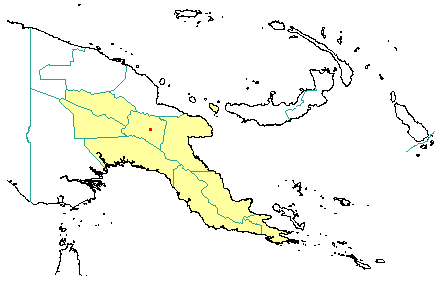
in PNGplants database
PNGTreesKey – Planchonella monticola (K.Krause) H.J.Lam |
Barry Conn (NSW) & Kipiro Damas (LAE).
Guide to trees of Papua New Guinea
Copyright held by the authors, National Herbarium of New South Wales, and Papua New Guinea National Herbarium
Nova Guinea Vol. 14: 561 (1932)
Family: Sapotaceae
Dicotyledon
Timber Group: Occasional timber species
Field Characters: Large canopy tree (20-30 m high) or Small sub-canopy tree; Bole cylindrical (usually 80-100 cm diam.); crooked (bole 10-17 m long); buttresses buttresses absent; spines spines absent; aerial roots aerial roots absent; stilt roots stilt roots absent; Bark brown, slightly rough or almost smooth, pustular, lenticels irregular; Subrhytidome (under-bark) green or dark red; less than 25 mm thick, 10.0; bark blaze consisting of one layer; faintly to non-aromatic; outer blaze pale yellow, pink, or red, markings absent, slightly granular with splinters; inner blaze pale yellow, pink, or red, markings absent, granular with splinters; bark exudate (sap) present, white/milky, flowing, colour not changing on exposure to air, sticky; terminal buds not enclosed by leaves.
Indumentum: Complex hairs absent; stinging hairs absent; mature twig indumentum (hairs) absent.
Leaves: Leaves spaced along branches, spiral (leaves occurring singly at a node and arranged spirally up the branchlet) (internodes very short), simple (a leaf composed of a single blade); petiole present (15-20 mm long), not winged, attached to base of leaf blade, not swollen; leaves broadest at or near middle, (8.0-) 17.0-20.0 cm, (2.0-) 4.0-5.0 cm; symmetric, entire, not dissected or lobed, rarely emarginate or retuse, obtuse, or acuminate (shortly), venation pinnate, secondary veins open, prominent, intramarginal veins absent; leaves lower surface pale brown or red, upper surface dull dark green, indumentum (hairs) present, indumentum (hairs) dense or sparse; absent; domatia absent; stipules absent.
Flowers: Inflorescence axillary, flowers single, cones absent; flowers bisexual, stalked (pedicel c. 8 mm long), flowers with many planes of symmetry, 6.0 (c.) mm long, diameter small (up to10 mm diam.) (c. 7 mm diam.); perianth present, with distinct sepals and petals whorls, inner perianth white; 5, some or partly joined; stamens 5, present (short), free of each other, joined to the perianth; ovary superior, carpels joined (when more than one), locules 5; styles solitary, 1.
Fruits: Infrutescence single, fruit 80.0-100.0 mm long, dark red or purple, not spiny, fleshy, simple, indehiscent, berry; seeds 1-5, not winged, broad (as wide as long) (broadly ellipsoid).
Distribution: Morobe, Western Highlands, Eastern Highlands, Southern Highlands, Gulf, Central, Northern & Milne Bay.
 | Botanical records in PNGplants database |
Notes: Notes This species was been tranferred to Pouteria monticola (K.Krause) H.J.Lam and this view was accepted by Pennington, T.D. (1991) The Genera of Sapotaceae (Royal Botanic Gardens Kew & New York Botanical Garden). However, it is here maintained within the genus Planchonella until the relationship between Pouteria and Planchonella is resolved.